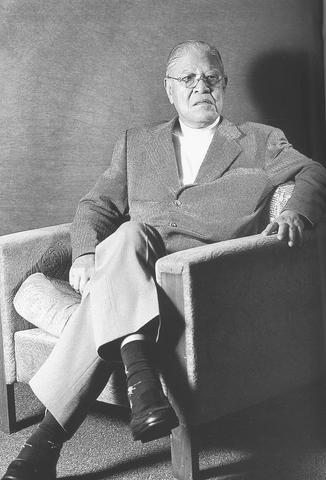The audio equipment provider-turned-photographer Tseng Min-hsiung (曾敏雄) has his particular approach to portraiture. While the more orthodox portrait photographers aim to shape a larger-than-life image of their celebrity subjects, Tseng instead tries to capture the moment when people reveal their life stories with their eyes.
In a portrait of former president Lee Teng-hui (李登輝) in 2002, Tseng deliberately provokes the statesman out of his habitual position, smiling magnificently in his adorned sofa, and caught the moment when Lee was slightly shocked and almost piqued at Tseng's impudent request. That moment, Tseng said in an interview with the Taipei Times, was Lee at his truest.
Lee's portrait and those of 99 other famous personalities are currently on show in Face's Talk, (台灣頭) Tseng's solo exhibition at the National Museum of History (國立歷史博物館).

PHOTO COURTESY OF THE ARTIST
In 1999, the then 34-year-old audio equipment shop owner decided to photograph 30 artists in central Taiwan, with the encouragement of well-known art critic Hsieh Li-fa (謝里法). This was Tseng's first serious photographic project. After the series was complete, Tseng gave himself the task of photographing 100 leading figures in different industries in Taiwan.
"When Paul Gauguin returned from his two-year stay in Tahiti to France, he said that he'd become more barbaric but much wiser. I felt the same about doing the portrait series," Tseng said.
Tseng said that selecting 100 "heads of Taiwan" proved more difficult than the photography. The majority of his selection were artists and writers, instead of political and business magnates, which seems to emphasize the influence cultural luminaries have on the history of Taiwan.
"There are few real statesmen, only politicians, and politicians come and go. Artists' works are handed down from generation to generation. They have a wider influence over Taiwan," Tseng said.
Viewers expecting to see only the big names in Taiwan may find the portrait of non-celebrity Lin Guan-ting (林冠廷), a 15-year-old boy with Down's syndrome, quite incongruous. "I made an exception for the boy when I saw his boundless imagination as he painted and his devoted manner when writing calligraphy. His
personality moved me deeply, so I decided to include him in the series," Tseng said.
For a little-known photographer like Tseng, having the country's most renowned or famous people agree to be
photographed was not easy.
Lin Huai-min (林懷民), artistic director of Cloud Gate Dance Theatre and Taiwan's best-known choreographer, and Gao Hsi-guen (高希均), economist and publisher of Commonwealth magazine, are both known to be extremely selective about their photographers. Tseng admitted that he made repeated and tenacious efforts to win their trust.
Believing that there are many more "heads of Taiwan" who are not shown in the present series, Tseng said that he would continue the project for an indefinite time to capture the images of all of those people who have shaped today's Taiwan.
Face's Talk
Tseng's solo exhibition, is set to run through Feb 22 at the National Museum of History, 49 Nanhai Rd, Taipei

May 18 to May 24 Pastor Yang Hsu’s (楊煦) congregation was shocked upon seeing the land he chose to build his orphanage. It was surrounded by mountains on three sides, and the only way to access it was to cross a river by foot. The soil was poor due to runoff, and large rocks strewn across the plot prevented much from growing. In addition, there was no running water or electricity. But it was all Yang could afford. He and his Indigenous Atayal wife Lin Feng-ying (林鳳英) had already been caring for 24 orphans in their home, and they were in

On May 2, Chinese Nationalist Party (KMT) Chairman Eric Chu (朱立倫), at a meeting in support of Taipei city councilors at party headquarters, compared President William Lai (賴清德) to Hitler. Chu claimed that unlike any other democracy worldwide in history, no other leader was rooting out opposing parties like Lai and the Democratic Progressive Party (DPP). That his statements are wildly inaccurate was not the point. It was a rallying cry, not a history lesson. This was intentional to provoke the international diplomatic community into a response, which was promptly provided. Both the German and Israeli offices issued statements on Facebook

Even by the standards of Ukraine’s International Legion, which comprises volunteers from over 55 countries, Han has an unusual backstory. Born in Taichung, he grew up in Costa Rica — then one of Taiwan’s diplomatic allies — where a relative worked for the embassy. After attending an American international high school in San Jose, Costa Rica’s capital, Han — who prefers to use only his given name for OPSEC (operations security) reasons — moved to the US in his teens. He attended Penn State University before returning to Taiwan to work in the semiconductor industry in Kaohsiung, where he

President William Lai (賴清德) yesterday delivered an address marking the first anniversary of his presidency. In the speech, Lai affirmed Taiwan’s global role in technology, trade and security. He announced economic and national security initiatives, and emphasized democratic values and cross-party cooperation. The following is the full text of his speech: Yesterday, outside of Beida Elementary School in New Taipei City’s Sanxia District (三峽), there was a major traffic accident that, sadly, claimed several lives and resulted in multiple injuries. The Executive Yuan immediately formed a task force, and last night I personally visited the victims in hospital. Central government agencies and the